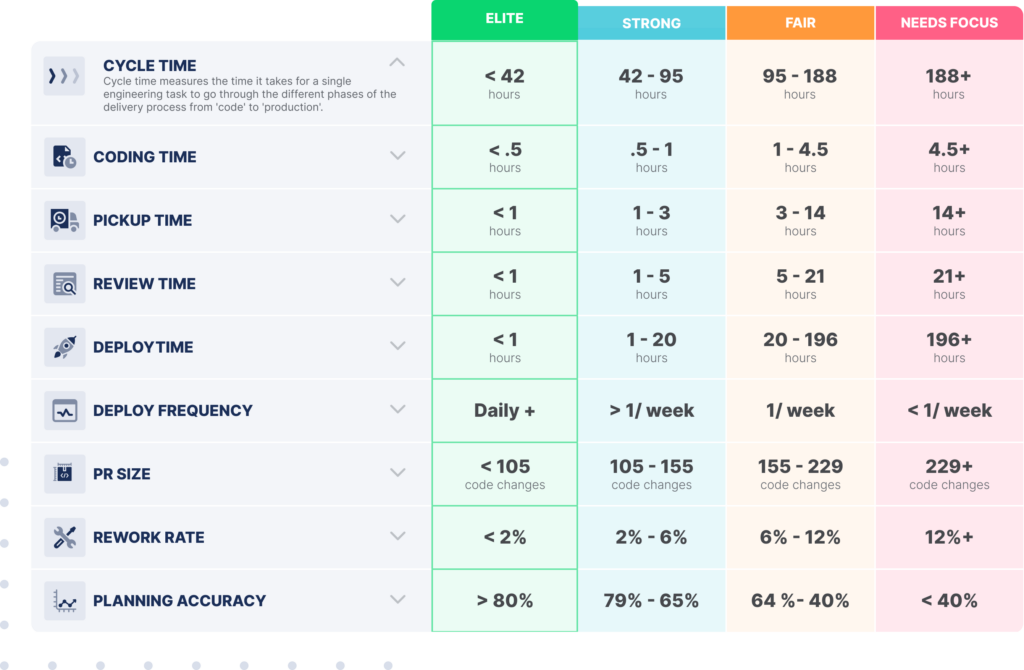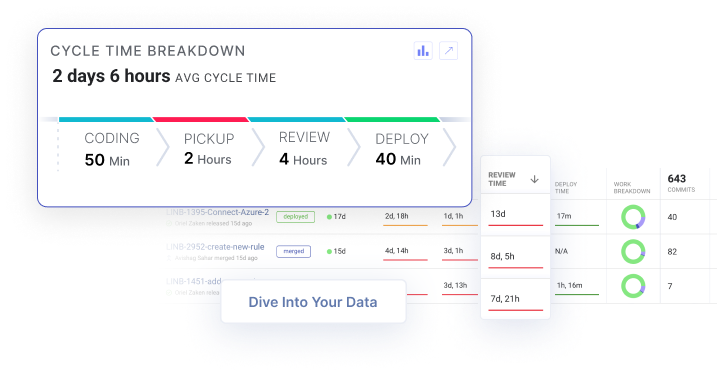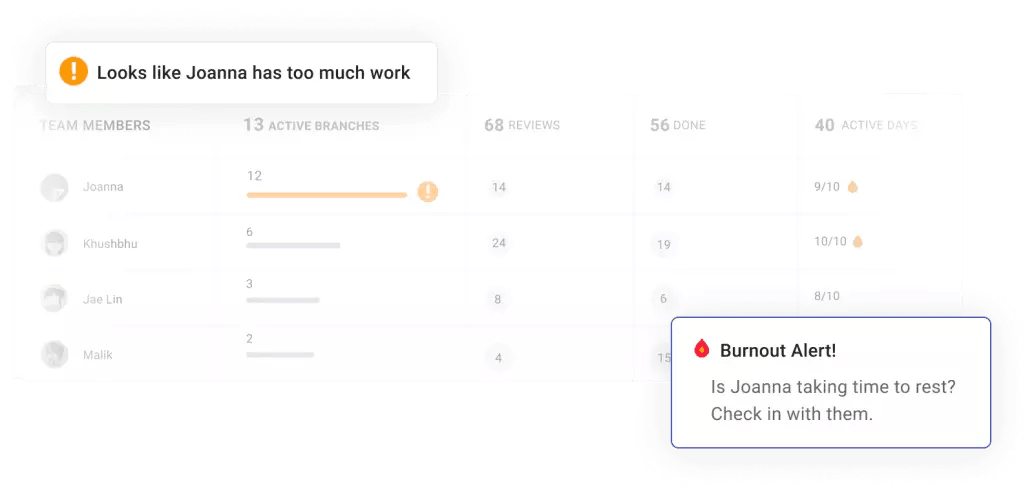If you’re an engineering leader, you want to boost the frequency of your deployments without sacrificing quality. But as you’re well aware, this is much easier said than done.
In this article, we’ll provide you with a few tips for how to improve scrum team productivity without harming the quality of code your team ships nor the well-being of your team members.
Benchmark Your Team
Before you can make improvements, you have to know what you need to improve.
With LinearB, in minutes you can establish your team’s numbers for metrics such as:
But a number in isolation doesn’t tell you how you’re performing. For that, you need a reference point.
LinearB analyzed almost 2,000 development teams to establish benchmarks for 9 key engineering metrics:
 Want to learn more about being an elite engineering team? Check out this blog detailing our engineering benchmarks study and methodology.
Want to learn more about being an elite engineering team? Check out this blog detailing our engineering benchmarks study and methodology.
Once you know how you’re performing, you can focus your efforts on the highest leverage areas to achieve the biggest gains in productivity.
Speed Up Cycle Time
Cycle time captures how long it takes to go from the first line written to a new piece of code being deployed. It is the super metric: All the other ones feed into it.
Ultimately, you want your team shipping code as quickly as possible, which means you want the lowest possible cycle time. To actually achieve this, you need to break down cycle time into smaller parts to identify bottlenecks.
With LinearB, you can measure your overall cycle time as well as how long it is taking your team to move through each of the four subcomponents of a development cycle. And with one click, you can look at the cycle time of individual issues so that you can find the specific issues causing delays.
 Get context around cycle time bottlenecks in one click. Diving into your data has never been this easy. Get started with our free-forever account today!
Get context around cycle time bottlenecks in one click. Diving into your data has never been this easy. Get started with our free-forever account today!
Improve Planning Accuracy
If you’ve worked as a developer, you’ve almost certainly had to muddle through unproductive and disorderly sprints which end in disappointing sprint reviews because you fall short of your sprint goals.
Many of the problems during a sprint stem from poor sprint planning: Taking on too many product backlog items, misestimating the number of story points, or choosing the wrong user stories.
High planning accuracy enables development teams to take charge of their sprints, deliver on their promises, consistently ship business value, and drive alignment with the rest of the organization.
With LinearB, it’s easy to see how accurately you’re planning. You can see how your Planning Accuracy is changing over time so that you can be mindful of it and drive constant improvement.

Keep Meetings Brief and to the Point
We’re all aware that Scrum teams have plenty of ceremonies to attend, but they’re a good use of time because they have a clear goal and agenda. In the daily Scrum meeting, for example, everyone understands that they need to concisely update the team on their progress, get help, and give help.
A one-hour meeting doesn’t take up just one hour. It takes up an hour from every participant. When viewed this way, it’s easy to appreciate how costly meetings can be and therefore why they need to be efficient and productive.
The most effective thing you can do to cut back on time-wasting meetings is to always have a meeting agenda. This year during LinearB’s INTERACT Conference, Kathryn Koehler, Director of Developer Productivity Engineering at Netflix, shared a motto that we loved: “No agenda, no attenda.” You can watch the full excerpt below:
By giving you detailed insights into processes of a development team, LinearB helps team leads, product owners, project managers, and Scrum coordinators (formerly known as Scrum masters), to identify the things that the team needs to discuss and work through. With that information, you can construct the agenda and come out of the meeting with tangible progress.
Avoid Doing Multiple Things at One Time
These days, we’re all multitasking all the time. But it is killing our productivity. Eight work hours during which you change tasks every 15 minutes is far less productive than eight work hours spent concentrating on one task.
Developers especially need uninterrupted time to focus deeply on a problem; otherwise, they could end up shipping code that is merely “good enough” which results in technical debt.
As a team lead, it’s hard to know how much your developers are having to context switch without watching over their shoulder as they work (which no one likes!). But with LinearB, you can see how much is on your developers’ plates, which enables you to manage Work in Progress (WIP) across your team. LinearB will even proactively inform you if a developer has maybe taken on too much and is at risk of burning out.

The Bottom Line
Improving the productivity of a development team means that your company can ship more value, bring in more revenue, and grow.
Unfortunately, the dynamic that arises far too often is that more and more is asked of the development team, and in trying to match those demands, the developers end up overworked and demotivated because they feel like no matter how hard they try, they’re not doing enough.
As a team lead, it is important to understand how much capacity your development team has and then to work intelligently to raise that capacity. LinearB gives you the metrics you need to identify the bottlenecks limiting your team’s velocity while also protecting the long-term health of the members of your team.




